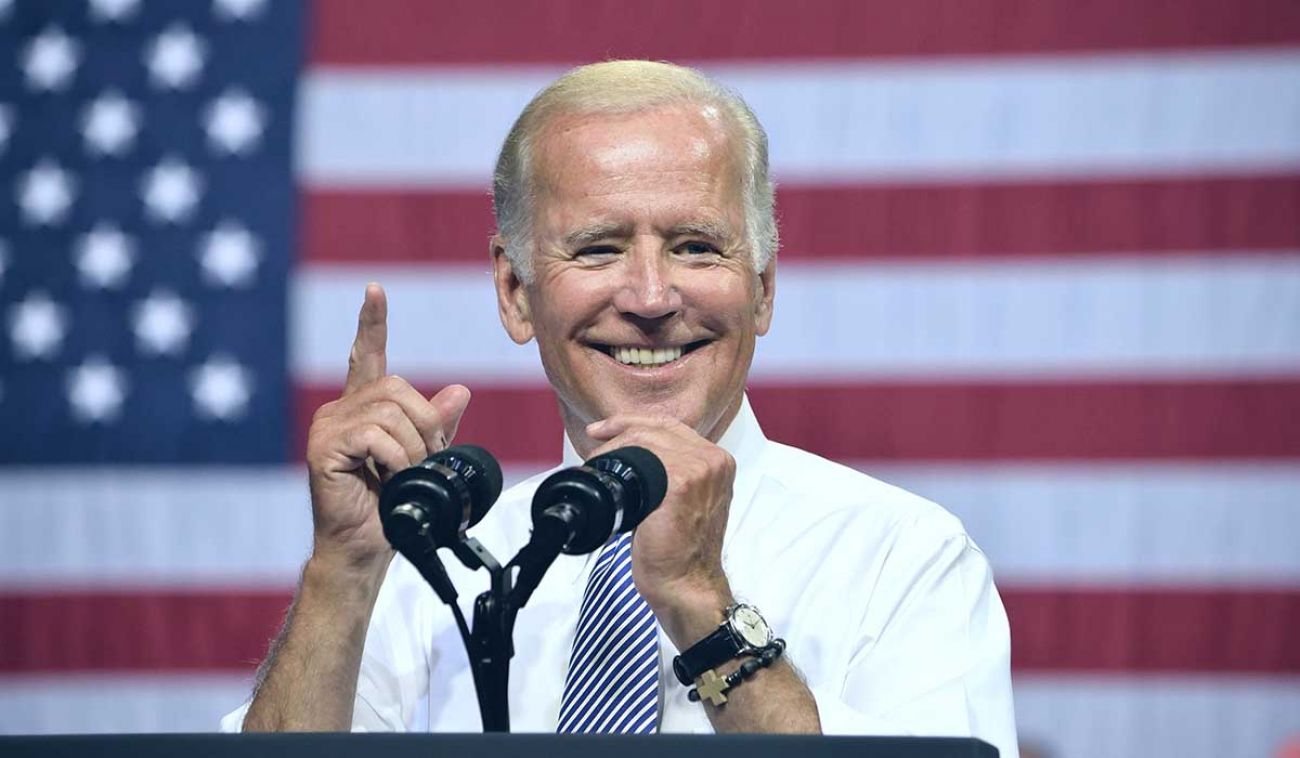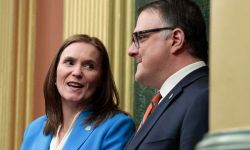Joe Biden leads Donald Trump in Michigan polls. Will they be wrong again?

LANSING -- One week out from the 2016 election, Democrat Hillary Clinton led Republican Donald Trump in Michigan by an average of 7 percentage points in public opinion polls. By Election Day, polls still narrowed but still favored Clinton by an average of 3.6 points.
Trump went on to win the state by 10,704 votes, about 0.02 percentage points, the narrowest margin in Michigan history.
Fast forward four years, and Trump is again down in Michigan polls. As of Tuesday, one week out from the election, he was trailing Democrat Joe Biden by an average of 9 points, according to Real Clear Politics. The data gurus at FiveThirtyEight give Biden a 95 percent chance of victory in Michigan.
So can Michiganders trust those polls again? Bridge Michigan spoke to pollsters in the past week, and they acknowledge mistakes but generally defend their work from 2016.
What the public forgets, they say, is that polls tightened in the final days, putting Trump within striking distance, and a large number of previously undecided voters who went for the Republican on Election Day.
Even so, they say polls have changed since 2016, as have several factors including a huge decline in the number of undecided voters this year.
Learning from mistakes
Michigan pollster Steve Mitchell is still haunted by 2016.
While other polls generally showed the race tightening in the last week, his final survey showed Clinton expanding her lead on Trump from 3 to 5 points. The poll of 1,007 voters, conducted for Fox 2-Detroit five days before the election, gave Clinton a 46 percent to 41 percent advantage, with 10 percent going to third-party candidates and just 3 percent undecided.
- Joe Biden is favored to win Michigan but can he build a Democratic wave?
- How Donald Trump can come from behind and win Michigan
- Five things you missed not standing in the rain with Donald Trump
- Michigan has 1M unreturned absentee ballots. And mail delays are common.
- 2020 Election Tracker | Biden back on Saturday; Trump in Lansing Tuesday
Mitchell blames his miss on a last-minute methodological change.
Pollsters typically make small adjustments — called weighting — to try to ensure their sample reflects the demographics of the wider population they are trying to survey. And in making a late adjustment in 2016, Mitchell said he ended up “overweighting young people” who tended to favor Clinton.
“When you’re in this business, you only get redemption every four years,” Mitchell said, touting his relatively accurate numbers in the 2020 Democratic presidential primary, which was difficult to poll given the huge candidate field.
This time, Mitchell said he’s using new techniques to connect with hard-to-reach voters, including text messaging those who may not answer their phone.
Another lesson he learned from 2016: Highly educated voters, who are more likely to be Democratic, are more likely to participate in polls. So “you have to balance that,” he said.
Reaching more voters by cell phone
Glengariff Group Inc. didn’t do much public polling late in 2016, when the Michigan race appeared to break decisively for Trump, but founder Richard Czuba said his firm fine-tuned its approach over the past four years, partially by pushing for more cellphone interviews.
Those are more expensive because a prohibition on cellphone “robo-dialing” means operators must manually dial each number. Cellphone users are also significantly less likely to answer calls than voters with landlines, meaning pollsters have to make extra calls to get the same number of respondents.
Cellphones made up 40 percent of Glengariff’s sample in 2016 but now make up 50 percent, said Czuba, whose firm does polling for The Detroit News, WDIV-TV and other clients. That means in a survey of 600 likely voters, 300 of them answered a call on their cellphone and agreed to answer questions.
“Our goal, especially in this election where we’re seeing motivation through the roof, is to cast a wide net amongst Michiganders who are registered to vote and let them tell us what they plan to do,” he said.
A pollsters defense of pollsters
While polls got a bad rap in 2016, national surveys were “right on the money,” said Bernie Porn of EPIC-MRA in Lansing, which conducts surveys for the Detroit Free Press, WOOD-TV and other private clients.
Final polls had her up by 3.2 percentage points, and she won the popular vote by 2.1 points. Trump won more states to win the Electoral College, however, which made him the 45th president of the United States.
Here in Michigan, Porn noted his own poll results were fluctuating dramatically in the run-up to the Nov. 8 election, suggesting Clinton’s support was soft and could “erode.”
The 11-point lead she had in late July plummeted to 3 points in September after she appeared to faint at a 9/11 ceremony, climbed back up to double digits in early October and fell to 7 points by late October, right before FBI Director James Comey announced he was restarting an investigation into her email servers.
EPIC-MRA’s final poll, concluded four days before the election, gave Clinton a 4-point lead but also had a 4-point margin of error.
“I just think they decided late,” Porn said of 2016 voters. “I think the Comey letter may have had an impact.”
Fewer undecided voters means more certainty
That final EPIC-MRA poll of 2016 showed Clinton leading Trump 42 percent to 38 percent, with 7 percent going third party. But the most telling number, according to experts, may have been the13 percent of voters who said they were either undecided or refused to answer.
“The polls last time were reflecting a great deal of uncertainty,” said Adrian Hemond, a Democratic consultant with Grassroots Midwest in Lansing.
There seems to be less of that in 2020.
Michigan pollsters are finding significantly fewer undecided voters who could break late for either candidate on Nov. 3. And notably, Biden has topped 50 percent in five of the last six publicly released polls of Michigan voters, a mark Clinton surpassed in only one of the last six polls of 2016.
“For months, we’ve seen miniscule numbers of undecided voters,” Hemond said. That’s not a one-off. That’s a durable result that everyone is getting. Everyone has made up their mind about this election, and they’ve made up their mind based on how they feel about the president.”
Unlikely and new voters may skew polls
Public polling suggests Trump is losing support with highly educated voters in areas like Oakland and Kent counties. But his campaign is doubling down on rural areas in an attempt to build on wins there from 2016.
By visiting areas like Saginaw and Muskegon, which typically don’t get much attention from presidential candidates, Trump is trying to draw out irregular voters and register new ones, said John Sellek, a GOP strategist with Harbor Strategic Public Affairs in Lansing.
Those new or reluctant voters may not show up in public opinion polling, Sellek said. They may not be on call lists, and if they are “so out of touch” that they had not registered to vote until now, “I think it’s unlikely that they’re going to be willing to answer a call from a stranger.”
There’s new technology and fewer landlines, which makes it harder for pollsters to reach voters who may also be distrustful because of the global pandemic and wary that sharing their views could lead to the kind of “social shaming” that is increasingly common on social media.
“All these factors are contributing to making it very difficult for pollsters,” Sellek said. “We have to trust polling to a certain extent, but we also have to take it with a grain of salt.”
Democrats aren’t banking on the polls either
While Democrats feel good about Biden’s chances, the 2016 polls are “the ghosts of the past haunting us today,” said Greg Bowens, a Democratic consultant with Bowens & Co. in metro Detroit.
“It makes us a little reluctant to believe them, to be honest.”
Bowens doubts that there are many Trump supporters who are still “ashamed” to admit that to pollsters, but he’s concerned recent results may not reflect the Trump campaign efforts to register new voters and appeal to the disaffected.
“I’ve seen the Trump boat caravan on Lake St. Clair and caravans of Trump cars on the east side of Detroit and the eastern suburbs,” he said. “And you wonder where that level of enthusiasm comes from when we’re faced with all the things we’re faced with in this state.”
“Everybody's mad for a reason, one reason or another, whether it's policing or the pandemic or the economy and the lockdowns, and that makes you wonder whether or not the polls are right.”
A snapshot, not a prediction
“Polls are meant to be a snapshot in time,” said Jenell Leonard, a GOP consultant with the Marketing Resource Group, which conducts both public and private polling for clients.
Polling that shows Biden with a 7-point lead in Michigan two weeks out from the election should not be read as a prediction that Biden will win Michigan by 7 points.
Instead, such a poll would suggest that Biden would win Michigan by 7 points if the election was held that day -- two weeks early.
“Two weeks is an eternity in politics,” Leonard said.
Czuba, the Glengariff Inc. pollster, said the public shouldn’t even look at polls.
The purpose of public polling is not simply to show which candidate is leading. It’s to inform the public why people are making the decisions they are making, and “what’s driving” their potential vote. That’s why his recent polls on the presidential race have also asked voters what they think about the Affordable Care Act, protections for pre-existing conditions, a U.S. Supreme Court vacancy and legal abortion rights, Czuba said.
“I am very careful, and I think the media should be very careful, about driving specific narratives the closer we get to Election Day,” he continued. “Those narratives can fundamentally shift voter motivation.”
That may have happened in 2016, he said: “The narrative was Hillary Clinton was going to win even though we were seeing internally a tightening of the race. What we saw was a collapse of motivation.”
See what new members are saying about why they donated to Bridge Michigan:
- “In order for this information to be accurate and unbiased it must be underwritten by its readers, not by special interests.” - Larry S.
- “Not many other media sources report on the topics Bridge does.” - Susan B.
- “Your journalism is outstanding and rare these days.” - Mark S.
If you want to ensure the future of nonpartisan, nonprofit Michigan journalism, please become a member today. You, too, will be asked why you donated and maybe we'll feature your quote next time!




